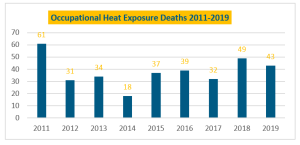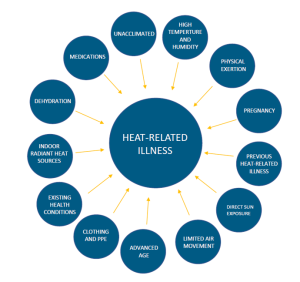Occupational Injuries and Fatalities Rising with the Summer Heat
Posted: July 14th, 2023
Authors: All4 Staff
With the summer heat quickly rising, what are you doing to do to avoid occupational heat exposure for your employees? Occupational heat exposure can lead to heat related injuries, illnesses, and in some cases, become fatal. Under the General Duty Clause, Section 5(a)(1) of the Occupational Safety and Health Act of 1970, employers are required to provide their employees with a place of employment that “is free from recognized hazards that are causing or likely to cause death or serious harm to employees.” The Bureau of Labor Statistics reports an average of 38.22 worker-related deaths per year in U.S. due to environmental heat exposure. The Bureau of Labor Statistics Experts believe the actual number of heat-related fatalities may be underreported or misreported as another cause, such as heart attacks. Along with the average of 38.22 worker-related deaths, exposure to environmental heat leads to an average of 2,830 recordable occupational injuries and illnesses per year involving days away from work. June through September creates the highest risk and Texas, California, Kanas, and South Carolina tend to have the highest number of nonfatal injuries and illnesses due to heat exposure according to the Bureau of Labor Statistics. OSHA has published many heat exposure case studies as a result of enforcement investigations. These studies may help employers better understand the risks of occupational heat exposure and lessons learned.

Who is most at risk?
Occupational heat exposure can occur both indoors and outdoors and does not always occur during a heat wave. The following is a list of industries where workers are more likely to suffer heat-related illnesses.
| Outdoors | Indoors |
| Agriculture | Bakeries, kitchens, laundries (any sources with indoor heat-generating appliances) |
| Construction | Electrical Utilities (boiler rooms) |
| Landscaping | Iron and steel Mills |
| Package Delivery | Manufacturing with local heat sources like furnaces (paper products) |
| Oil and gas well operations | Warehousing |
What is your responsibility as an employer?
OSHA suggests that all employers, especially those who’s employees work outdoor in warm weather, are around heat sources such as ovens, fires, or hot tar, perform strenuous physical activities, or work in heavy or non-breathable work clothes create a Heat Illness Prevention Plan. Many U.S. states have their own OSHA approved state plans, so it is important to know those guidelines to stay in compliance. For example, California’s Heat Illness Prevention Standard requires employers to provide training, water, shade, and planning. A temperature of 80°F triggers the requirements. NIOSH also has a recommended heat standard. The graphic below shows some of the many elements to take into consideration when creating a plan and training for your employees who are exposed to hazardous heat.
Important components to consider when creating a Heat Illness Prevention Plan include:
- Who will provide daily oversight of working conditions?
- How will you help new workers or workers returning from any type of leave acclimatize to the environment?
- How will you ensure that first aid is available and that a protocol is in place to handle situations where care beyond first aid is needed?
- What engineering controls will be used to mitigate heat stress?
- How will heat stress be measured and how will you determine if heat stress is hazardous?
- How to respond when the National Weather Service issues a heat advisory or heat warning?
- What training will be provided to workers and supervisors to recognize early symptoms of heat stress?
What happens now?
OSHA is continuing to push forward with their Heat Illness Prevention Campaign to protect employees, enforce the General Duty Clause, and educate employers. ALL4 has immense experience in helping employers create policies meeting regulatory requirements and we will continue watching the developing rules and regulations around Occupational Heat Exposure.
If you have concerns about the potential implications of occupation heat exposure, other job hazards, policies, regulations, or EHS digital solutions for your company and you’d like to discuss them, feel free to contact your ALL4 Project Manager or info@all4inc.com. We’d be happy to assist you in any way we can!

